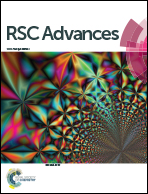Synthesis, characterization and biological evaluation of cationic hydrazone copper complexes with diverse diimine co-ligands†
Abstract
Four new copper(II) complexes containing triphenylphosphonium conjugated salicylaldehyde-(4-fluorobenzhydrazone), (L) with the formulation [CuL]Cl(1), [Cu(phen)L]Cl(2), [Cu(bpy)L]Cl(3), [Cu(dmbpy)L]Cl(4), (where L = doubly deprotonated hydrazone; phen = 1,10′-phenanthroline; bpy = 2,2′-bipyridine; dmbpy = 5,5′-dimethyl-2,2′-bipyridine) have been synthesized. The compounds were characterized by spectroscopic methods and, in the case of crystalline products, by X-ray crystallography. The topoisomerase I (topo I) inhibition, DNA binding and cleavage activities and cytotoxicity of the compounds were studied. A DNA relaxation study demonstrated that all the copper complexes successfully inhibit topo I enzyme by binding to topo I as the preferred pathway. Complex 1 is the most active with starting inhibitory concentration ≈20 μM. The planarity of the tridentate hydrazone Schiff base ligand and the diimine co-ligands increase the binding affinity to DNA. The presence of the 1,10′-phenanthroline co-ligand in complex 2 induces plasmid DNA (pBR322) cleavage without exogenous agents. It is noteworthy that the addition of diimine co-ligands to the copper(II) complex enhanced the cytotoxicity of the compounds, especially against the human prostate adenocarcinoma cell line (PC-3). Complex 2 exhibits the highest activity against PC-3 with the IC50 value of 2.47 ± 0.37 μM. Annexin V/propidium iodide analysis showed that compound 1 induces apoptotic and necrotic cell death, whereas compound 2–4 work mainly through apoptosis.


 Please wait while we load your content...
Please wait while we load your content...